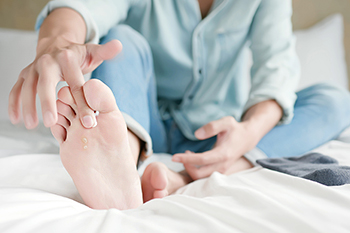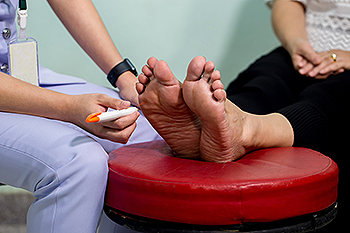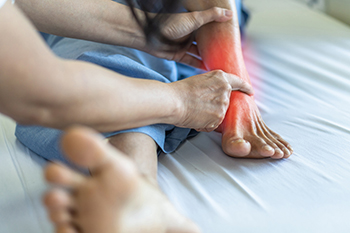Items filtered by date: February 2022
How to Help Prevent Athlete’s Foot
 Getting a case of athlete’s foot can be annoying, for several reasons. First of all it causes itching between the toes, as the skin becomes dry and scaly. Second, in more severe cases, it can form blisters, cracks, and inflammation. Lastly, it spreads very easily, so try to avoid touching the affected area. Athlete’s foot is caused by a virus that thrives in moisture and dampness and is especially virulent in warmer temperatures. It is often picked up in swimming pools, locker rooms, and gyms, and it can be spread within the home in the shower or tub. It’s a good idea to wear protective foot coverings in damp or moist areas, keep your feet clean and dried – especially between the toes – as much as possible, and change your socks often if your feet have a tendency to become sweaty. There are several antifungal sprays and creams available over the counter that may bring some relief. If the condition persists, it may be a good idea to consult a podiatrist who can evaluate its severity and offer appropriate treatment options for you.
Getting a case of athlete’s foot can be annoying, for several reasons. First of all it causes itching between the toes, as the skin becomes dry and scaly. Second, in more severe cases, it can form blisters, cracks, and inflammation. Lastly, it spreads very easily, so try to avoid touching the affected area. Athlete’s foot is caused by a virus that thrives in moisture and dampness and is especially virulent in warmer temperatures. It is often picked up in swimming pools, locker rooms, and gyms, and it can be spread within the home in the shower or tub. It’s a good idea to wear protective foot coverings in damp or moist areas, keep your feet clean and dried – especially between the toes – as much as possible, and change your socks often if your feet have a tendency to become sweaty. There are several antifungal sprays and creams available over the counter that may bring some relief. If the condition persists, it may be a good idea to consult a podiatrist who can evaluate its severity and offer appropriate treatment options for you.
Athlete’s Foot
Athlete’s foot is often an uncomfortable condition to experience. Thankfully, podiatrists specialize in treating athlete’s foot and offer the best treatment options. If you have any questions about athlete’s foot, consult with one of our podiatrists from Palmetto Podiatry Group of Anderson. Our doctors will assess your condition and provide you with quality treatment.
What Is Athlete’s Foot?
Tinea pedis, more commonly known as athlete’s foot, is a non-serious and common fungal infection of the foot. Athlete’s foot is contagious and can be contracted by touching someone who has it or infected surfaces. The most common places contaminated by it are public showers, locker rooms, and swimming pools. Once contracted, it grows on feet that are left inside moist, dark, and warm shoes and socks.
Prevention
The most effective ways to prevent athlete’s foot include:
- Thoroughly washing and drying feet
- Avoid going barefoot in locker rooms and public showers
- Using shower shoes in public showers
- Wearing socks that allow the feet to breathe
- Changing socks and shoes frequently if you sweat a lot
Symptoms
Athlete’s foot initially occurs as a rash between the toes. However, if left undiagnosed, it can spread to the sides and bottom of the feet, toenails, and if touched by hand, the hands themselves. Symptoms include:
- Redness
- Burning
- Itching
- Scaly and peeling skin
Diagnosis and Treatment
Diagnosis is quick and easy. Skin samples will be taken and either viewed under a microscope or sent to a lab for testing. Sometimes, a podiatrist can diagnose it based on simply looking at it. Once confirmed, treatment options include oral and topical antifungal medications.
If you have any questions, please feel free to contact our office located in Anderson, SC . We offer the newest diagnostic and treatment technologies for all your foot care needs.
Reminder: When Was the Last Time...?
How Do Bunionettes Form?
 A bunionette, also called a tailor’s bunion, is a bony outgrowth along the outside of the foot, at the base of the pinky toe. Bunionettes are thought to form due to inherited mechanical structure defects in the foot. When the area at the base of the pinky toe is put under excessive pressure and friction, usually from wearing shoes that are too narrow and rub against the toe, a bony outgrowth develops in this area. This deformity grows outwards and pushes the pinky toe inwards, toward the other toes. Bunionettes cause symptoms such as redness, swelling, and pain at the site of the bunionette, as well as a visible foot deformity that can make it difficult to wear certain types of shoes. If you have a painful bunionette, please seek the care of a podiatrist.
A bunionette, also called a tailor’s bunion, is a bony outgrowth along the outside of the foot, at the base of the pinky toe. Bunionettes are thought to form due to inherited mechanical structure defects in the foot. When the area at the base of the pinky toe is put under excessive pressure and friction, usually from wearing shoes that are too narrow and rub against the toe, a bony outgrowth develops in this area. This deformity grows outwards and pushes the pinky toe inwards, toward the other toes. Bunionettes cause symptoms such as redness, swelling, and pain at the site of the bunionette, as well as a visible foot deformity that can make it difficult to wear certain types of shoes. If you have a painful bunionette, please seek the care of a podiatrist.
If you are suffering from bunions, contact one of our podiatrists of Palmetto Podiatry Group of Anderson. Our doctors can provide the care you need to keep you pain-free and on your feet.
What Is a Bunion?
A bunion is formed of swollen tissue or an enlargement of boney growth, usually located at the base joint of the toe that connects to the foot. The swelling occurs due to the bones in the big toe shifting inward, which impacts the other toes of the foot. This causes the area around the base of the big toe to become inflamed and painful.
Why Do Bunions Form?
Genetics – Susceptibility to bunions are often hereditary
Stress on the feet – Poorly fitted and uncomfortable footwear that places stress on feet, such as heels, can worsen existing bunions
How Are Bunions Diagnosed?
Doctors often perform two tests – blood tests and x-rays – when trying to diagnose bunions, especially in the early stages of development. Blood tests help determine if the foot pain is being caused by something else, such as arthritis, while x-rays provide a clear picture of your bone structure to your doctor.
How Are Bunions Treated?
- Refrain from wearing heels or similar shoes that cause discomfort
- Select wider shoes that can provide more comfort and reduce pain
- Anti-inflammatory and pain management drugs
- Orthotics or foot inserts
- Surgery
If you have any questions, please feel free to contact our office located in Anderson, SC . We offer the newest diagnostic and treatment technologies for all your foot care needs.
Treating Peripheral Neuropathy
Peripheral neuropathy occurs when nerves in the extremities become damaged and dysfunctional. Peripheral neuropathy can cause numbness, tingling, burning/shooting pains and muscle weakness in the feet, along with cramps, swelling, sensitivity, and a loss of coordination and balance. This condition often makes it difficult for people to walk. Peripheral neuropathy is often caused by the elevated sugar levels associated with diabetes, but may also occur due to viral infections, injury, or as a side effect of taking certain medications or indulging in too much alcohol. A podiatrist can help treat peripheral neuropathy through pharmaceutical and physical therapy, custom orthotics for your shoes, or even nerve stimulation treatments. It is suggested that you call a podiatrist to explore treatment options for your peripheral neuropathy.
Neuropathy
Neuropathy can be a potentially serious condition, especially if it is left undiagnosed. If you have any concerns that you may be experiencing nerve loss in your feet, consult with one of our podiatrists from Palmetto Podiatry Group of Anderson. Our doctors will assess your condition and provide you with quality foot and ankle treatment for neuropathy.
What Is Neuropathy?
Neuropathy is a condition that leads to damage to the nerves in the body. Peripheral neuropathy, or neuropathy that affects your peripheral nervous system, usually occurs in the feet. Neuropathy can be triggered by a number of different causes. Such causes include diabetes, infections, cancers, disorders, and toxic substances.
Symptoms of Neuropathy Include:
- Numbness
- Sensation loss
- Prickling and tingling sensations
- Throbbing, freezing, burning pains
- Muscle weakness
Those with diabetes are at serious risk due to being unable to feel an ulcer on their feet. Diabetics usually also suffer from poor blood circulation. This can lead to the wound not healing, infections occurring, and the limb may have to be amputated.
Treatment
To treat neuropathy in the foot, podiatrists will first diagnose the cause of the neuropathy. Figuring out the underlying cause of the neuropathy will allow the podiatrist to prescribe the best treatment, whether it be caused by diabetes, toxic substance exposure, infection, etc. If the nerve has not died, then it’s possible that sensation may be able to return to the foot.
Pain medication may be issued for pain. Electrical nerve stimulation can be used to stimulate nerves. If the neuropathy is caused from pressure on the nerves, then surgery may be necessary.
If you have any questions, please feel free to contact our office located in Anderson, SC . We offer the newest diagnostic and treatment technologies for all your foot care needs.
When It Hurts to Bend Your Ankle
Ankle impingement occurs when either soft tissue or bone fragments get compressed, or trapped, if you bend your ankle. This impingement is usually a result of an acute injury, or prolonged stress from repetitive activities. Ankle impingement can either be anterior (affecting the front part of the ankle) or posterior (affecting the back part of the ankle). Anterior ankle impingement usually causes pain on the front/outside of the ankle when the ankle is bent upward (dorsiflexion). Posterior ankle impingement can produce pain in the back of the heel when the ankle is pointed downward (plantarflexion). Ankle impingement is often diagnosed in athletes who play soccer and football, as well as in dancers, gymnasts, and runners. If you have this type of ankle pain, a podiatrist can help you restore ankle stability with certain strengthening exercises, while treating pain and inflammation with rest, icing, anti-inflammatory medication, steroid injections, or even surgery in some cases.
Ankle pain can be caused by a number of problems and may be potentially serious. If you have ankle pain, consult with one of our podiatrists from Palmetto Podiatry Group of Anderson. Our doctors will assess your condition and provide you with quality foot and ankle treatment.
Ankle pain is any condition that causes pain in the ankle. Due to the fact that the ankle consists of tendons, muscles, bones, and ligaments, ankle pain can come from a number of different conditions.
Causes
The most common causes of ankle pain include:
- Types of arthritis (rheumatoid, osteoarthritis, and gout)
- Ankle sprains
- Broken ankles
- Achilles tendinitis
- Achilles tendon rupture
- Stress fractures
- Bursitis
- Tarsal tunnel syndrome
- Plantar fasciitis
Symptoms
Symptoms of ankle injury vary based upon the condition. Pain may include general pain and discomfort, swelling, aching, redness, bruising, burning or stabbing sensations, and/or loss of sensation.
Diagnosis
Due to the wide variety of potential causes of ankle pain, podiatrists will utilize a number of different methods to properly diagnose ankle pain. This can include asking for personal and family medical histories and of any recent injuries. Further diagnosis may include sensation tests, a physical examination, and potentially x-rays or other imaging tests.
Treatment
Just as the range of causes varies widely, so do treatments. Some more common treatments are rest, ice packs, keeping pressure off the foot, orthotics and braces, medication for inflammation and pain, and surgery.
If you have any questions, please feel free to contact our office located in Anderson, SC . We offer the newest diagnostic and treatment technologies for all your foot care needs.



